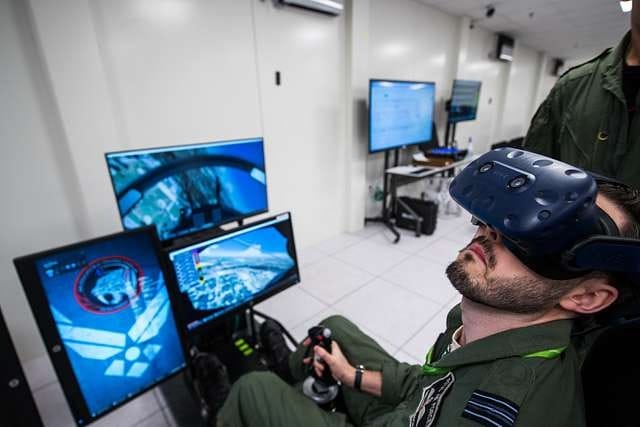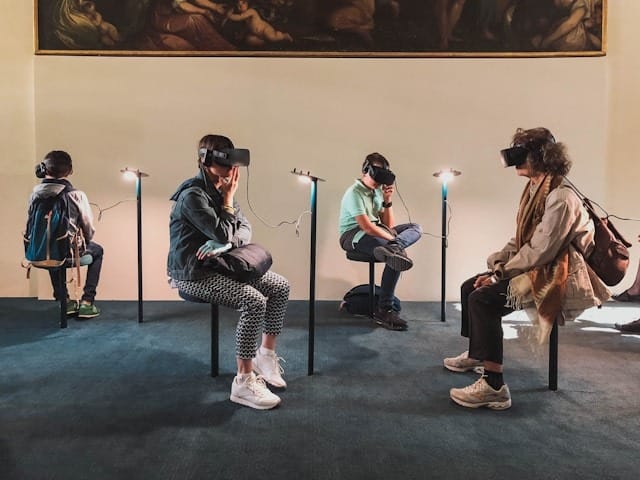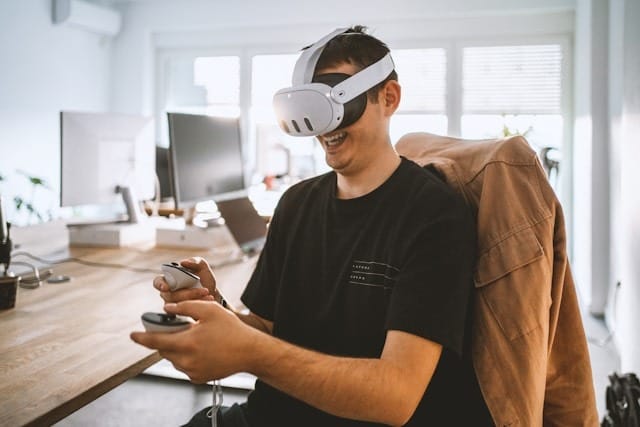Types of Virtual Reality: A Complete Guide to Immersive Worlds
Over 171 million people worldwide are actively using Virtual Reality, not just for gaming but also for learning, production, manufacturing, advertising, and healthcare. With immersive tech jumping from niche to mainstream, Virtual Reality is no longer a futuristic novelty. Using this technology, you can step into a digital world where you can walk through Mars, perform surgery, or relive history without leaving your chair.
In this article, you will learn the different types of Virtual Reality, how they differ, their pros and cons, and the emerging VR trends in 2026.
Fully Immersive Virtual Reality: The Ultimate VR Experience
Fully immersive Virtual Reality places you inside a completely simulated digital environment where your senses are isolated from the physical world. You interact naturally through motion, sound, and sometimes touch, achieving total immersion.
Characteristics
360° virtual environment with spatial audio.
Real-time motion and position tracking.
High-resolution visuals with low latency.
Haptic feedback for tactile simulation.
Realistic sense of presence and interaction.
Key Technologies Used
Head-Mounted Displays (HMDs): Meta Quest 3, HTC Vive Pro.
Motion Tracking Sensors: Cameras, gyroscopes, infrared systems.
Haptic Devices: Gloves and suits providing tactile feedback.
Spatial Audio: 3D sound simulation for immersion.
Powerful GPUs: Rendering high-resolution 3D environments.
Example

Imagine flying a Boeing 747 without leaving the ground. Flight schools use fully immersive VR simulators to train pilots in real cockpit conditions. These systems mimic turbulence, instrument panels, and sounds, offering authentic, risk-free training environments.
Benefits
Deep engagement and realism.
Enhanced retention in training and education.
Safe simulation for high-risk environments.
Supports collaboration in virtual workspaces.
Limitations
Expensive hardware and setup.
Requires significant physical space.
Possible motion sickness and fatigue in long sessions.
High system performance demands.
Non-Immersive Virtual Reality: Accessible and Versatile VR
Non-immersive Virtual Reality allows you to experience a virtual environment through a standard screen while staying fully aware of your physical surroundings. It's the most common and accessible form of VR, bridging everyday computing with interactive simulation.
Characteristics
Virtual environments are displayed on monitors, TVs, or mobile screens.
Interaction via traditional input devices such as keyboard, mouse, or controller.
Limited sensory engagement, primarily visual and auditory.
Real-world awareness is maintained during use.
Ideal for casual or professional 3D visualization.
Key Technologies Used
PCs and Consoles: Hardware for rendering 3D content.
Monitors or Touchscreens: Displaying virtual environments.
Input Devices: Keyboard, mouse, gamepad, or joystick.
Basic Audio Systems: Stereo or surround sound.
Example
When you explore a virtual museum tour on your laptop or design a 3D model in CAD software, you're using non-immersive VR. You interact with virtual objects on your screen, gaining spatial awareness and control without wearing a headset or isolating from reality.
Benefits
Cost-effective and widely available.
No specialized hardware or space required.
Easy to integrate with existing systems.
Ideal for learning, design, and remote visualization.
Limitations
Low immersion and engagement level.
Limited sensory realism.
Less effective for experiential training.
Dependent on display quality and system performance.
Semi-Immersive Virtual Reality: Balanced VR for Professionals
Semi-immersive Virtual Reality blends real and virtual elements, allowing you to interact with a simulated environment while maintaining partial awareness of your physical space. It offers a balance between accessibility and immersion, ideal for professional and educational use.

Characteristics
Partially immersive environment using large screens or projections.
Visual depth and realism create situational awareness.
Supports multiple users or group training.
Physical movement is limited compared to fully immersive VR.
Commonly used for simulation-based learning and design visualization.
Key Technologies Used
Large projection systems or multi-display setups to create wide-angle visuals.
Partial head-mounted displays or curved screens to enable limited immersion.
Motion tracking systems for detecting head and body orientation.
Spatial audio systems to add realistic sound depth and directionality.
Simulation engines (Unity, Unreal Engine) render interactive 3D environments.
Workstation-grade GPUs and processors to handle high-fidelity rendering.
Example
When automobile companies use CAVE (Cave Automatic Virtual Environment) to walk through a virtual life-size 3D model of a new car design, they're engaging in semi-immersive VR. It helps them visualize scale, ergonomics, and spatial alignment before any physical prototype is built.
Benefits
Cost-efficient compared to fully immersive VR.
Realistic visualization for complex training and design.
Encourages collaboration in shared virtual spaces.
Lower motion sickness risk and easier setup.
Limitations
Limited sensory engagement (no complete isolation).
Requires specialized display infrastructure.
Less portability compared to non-immersive systems.
Reduced depth of presence versus fully immersive experiences.
Augmented Reality (AR) vs. Virtual Reality (VR)
Although often mentioned together, Augmented Reality and Virtual Reality represent two distinct ways to blend the digital and physical worlds. While VR immerses you in an entirely virtual environment, AR enhances your real-world surroundings with digital overlays and interactive 3D content. Both are transforming industries from education and marketing to healthcare and manufacturing.
How They Differ
Immersion
VR isolates you from the physical world, replacing it entirely with a digital one.
AR keeps you grounded in reality while adding virtual elements on top.
Interaction
VR relies on controllers, gloves, and sensors for movement and input.
AR uses your camera, gestures, and voice to interact with overlays.
Experience
VR creates a complete sense of escapism, making it perfect for training, simulation, or entertainment.
AR enhances productivity and contextual learning by combining real and virtual insights.
Core Technologies
VR: Head-mounted displays (Meta Quest, HTC Vive, PlayStation VR), motion controllers, spatial audio, and high-end GPUs.
AR: Smartphones, tablets, smart glasses (Microsoft HoloLens, Magic Leap), LiDAR depth sensors, and AR development platforms (ARKit, ARCore).
Real-World Examples
VR: Beat Saber, VR Flight Simulators, virtual classrooms, and Meta Horizon Worlds.
AR: Pokémon GO, IKEA Place, Snapchat filters, and Microsoft HoloLens.
Integration and Convergence
AR and VR are rapidly merging into Mixed Reality (MR), a hybrid environment where real and virtual elements coexist and interact in real time. This convergence allows you to manipulate digital objects as though they were tangible, improving collaboration, design, and learning efficiency.

Devices like Apple Vision Pro and Meta Quest 3 already bridge the gap between augmented and virtual experiences, setting the foundation for Extended Reality (XR), the all-inclusive term for AR, VR, and MR technologies.
Industry-Specific VR Trends in 2025
Virtual Reality is evolving rapidly. Industries across aviation, healthcare, education, and entertainment are redefining how they use various types of Virtual Reality for efficiency and engagement.
Smarter Simulations in Aviation, Defense, and Healthcare
Fully immersive Virtual Reality has become an indispensable training tool for aviation, defense, and healthcare professionals. These industries rely on VR's ability to replicate real-world conditions with precision and safety.
Aviation
Airlines and flight schools now use advanced semi-immersive flight simulators that mirror cockpit layouts and flight dynamics. You can train pilots for turbulence, navigation errors, and system failures, without even leaving the ground.
Military
The defense sector uses Fully immersive Virtual Reality to simulate combat environments and tactical operations. Soldiers practice mission scenarios, team coordination, and stress management within controlled, repeatable digital settings.
Healthcare
Surgeons and medical trainees benefit from VR surgical simulators that mimic real anatomy and tissue behavior. This approach improves precision and confidence before operating on real patients.
Benefits
Cost-efficient, risk-free training environments.
Data-driven performance tracking.
Enhanced muscle memory and decision-making.
Limitations
High equipment costs.
Need for specialized instructors.
Occasional simulation fatigue.
Virtual Classrooms: Immersive Learning for a New Era
Semi-immersive Virtual Reality is transforming how you learn by turning classrooms into interactive, experiential environments. Currently, schools and universities are using VR to make lessons more engaging, inclusive, and effective.
Applications
Students can walk through the solar system or ancient civilizations in 3D.
Medical students explore the human body at a cellular level.
Remote learners join live VR classrooms, experiencing real presence.
Platforms like ENGAGE VR and VictoryXR Campus are already making this possible, helping educators deliver lessons that go beyond screens and textbooks.
Benefits
Increases engagement and understanding.
Enables practical, hands-on learning from anywhere
Makes education accessible to remote or underserved communities.
Limitations
Device and internet dependency.
Initial adaptation is required for students and educators.
Budget constraints for large-scale deployment.
Beyond Screens: The Future of VR Entertainment
Entertainment remains the beating heart of VR innovation. New trends in storytelling, gaming, and marketing are changing how you consume content and connect with brands.
Interactive Storytelling
Filmmakers are using Virtual Reality to let you step inside stories. Your choices shape the plot, creating personalized, cinematic adventures.
VR Esports
Competitive VR games like Echo VR and Onward have become mainstream, drawing huge audiences to fully immersive tournaments where physical movement meets digital gameplay.
Experiential Marketing
Brands are using VR experiences to engage customers emotionally. You can test-drive a car, visit a resort, or explore a new product virtually before buying.
Benefits
Heightens emotional engagement.
Expands creative storytelling possibilities.
Enhances brand awareness and retention.
Challenges
High production and content costs.
Limited access for non-VR users.
Conclusion: Navigating the Future of Virtual Reality
The future of Virtual Reality isn't just immersive; it's inevitable. As technology becomes more accessible and lifelike, VR is shaping how you train, learn, shop, and connect.
From Fully immersive Virtual Reality to hybrid AR-VR ecosystems, every innovation brings you closer to seamlessly blending the physical and digital worlds. The next wave of progress will make VR not just an experience, but a daily interface for work, creativity, and collaboration.
Ready to build immersive brand experiences that stand out? Empower your brand's marketing strategy with Flam, a full-stack, AI-first suite that helps brands create, publish, and scale interactive and immersive advertising experiences that captivate, convert, and connect.